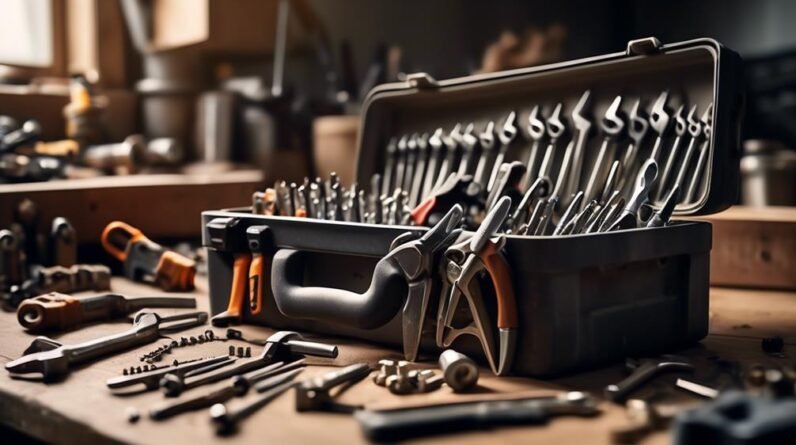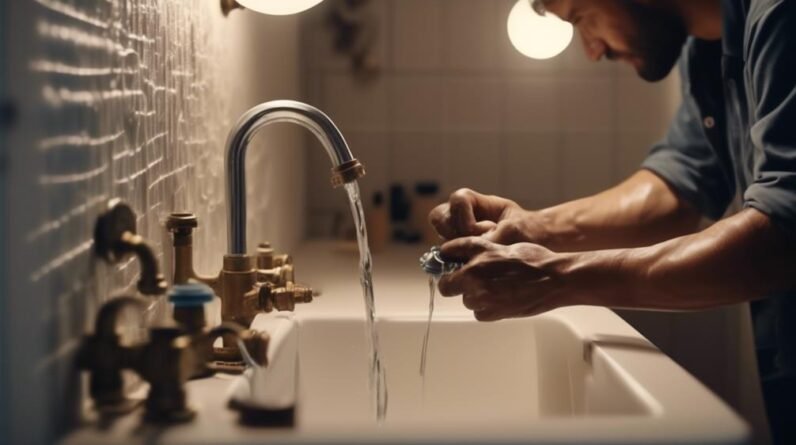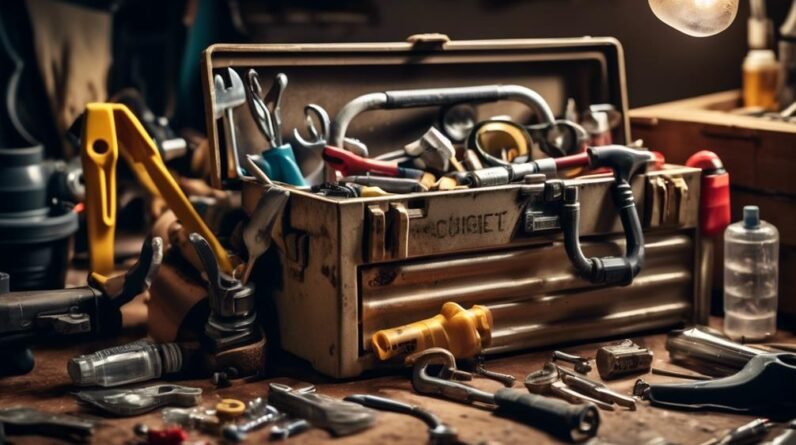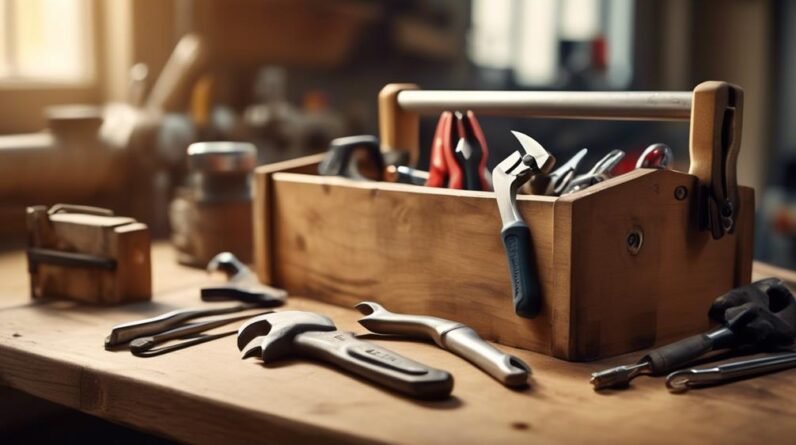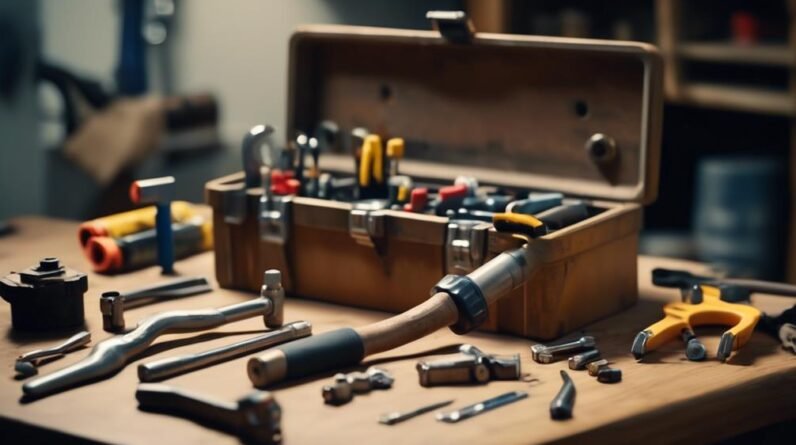
Have you ever found yourself facing a leaky faucet or a squeaky door that just won't quit? It can be frustrating to deal with these everyday home repair issues, especially when you're not sure where to start. But fear not, because there are some effective DIY hacks that can save you time, money, and headache. From patching a cracked tile to removing stubborn stains from surfaces, these simple yet ingenious tricks will have your home looking and functioning like new in no time. So, if you're ready to tackle those pesky household problems, keep reading to discover some clever DIY solutions that will leave you feeling like a true handyman or handywoman.
Key Takeaways
- Leaky faucets can often be repaired by replacing the worn-out washer, which is a simple and inexpensive DIY project.
- Squeaky doors can be fixed by lubricating the hinges with WD-40 or silicone spray and tightening loose screws.
- Cracked tiles and countertops can be repaired by filling the cracks with epoxy adhesive and replacing grout if necessary.
- Stains can be removed by blotting and using various cleaning solutions such as baking soda, hydrogen peroxide, and dish soap. Testing the solution on a small area is recommended before applying it to the stain.
- Clogged drains can be unclogged using a combination of baking soda and vinegar, hot water, or by fishing out debris with a wire hanger. Regular use of natural drain cleaners can help prevent future clogs.
Fixing a Leaky Faucet
If you find yourself dealing with a pesky leaky faucet, don't worry – fixing it is easier than you might think. One common cause of a leaky faucet is a worn-out washer. Fortunately, replacing a washer in a faucet is a simple and inexpensive DIY project that you can easily tackle on your own.
To begin, make sure to turn off the water supply to the faucet. This can usually be done by locating the shut-off valve underneath the sink. Once the water is turned off, you can start disassembling the faucet. Remove the handle by unscrewing the screw located either on top or underneath the handle. Next, use a wrench to unscrew the packing nut and remove the valve stem.
Once you have access to the valve stem, you will find the washer at the bottom. Gently remove the old washer and replace it with a new one of the same size and shape. Make sure to clean any debris or sediment in the faucet before reassembling it.
Repairing a Squeaky Door
Now that you've successfully fixed your leaky faucet, let's move on to repairing a squeaky door. A squeaky door can be annoying and disrupt the peaceful ambiance of your home. Fortunately, fixing it is a simple task that requires just a few minutes of your time. The two main culprits behind a squeaky door are usually dry hinges and loose screws. To start, you'll want to lubricate the hinges. Apply a small amount of lubricant, such as WD-40 or silicone spray, to the top and bottom hinges. Move the door back and forth a few times to ensure the lubricant reaches all parts of the hinge. If the door is still squeaking, you may need to tighten the screws. Using a screwdriver, gently tighten all the screws on the hinges, making sure not to over-tighten them. This should help reduce the friction and eliminate the squeak. If the squeak persists, you may need to replace the hinges altogether. Overall, repairing a squeaky door is a quick and simple DIY task that can greatly improve the comfort of your home.
Patching a Cracked Tile
To patch a cracked tile, gather the necessary materials and follow these simple steps:
- Start by cleaning the cracked tile and the surrounding area. Use a mild detergent and warm water to remove any dirt or grime. Make sure the tile is completely dry before proceeding.
- Fill the crack with an epoxy adhesive. Apply the adhesive directly into the crack, using a toothpick or a small brush. Make sure to fill the crack completely and evenly.
- Use a putty knife to remove any excess adhesive from the surface of the tile. Smooth out the surface to ensure a seamless finish.
If you are also replacing grout or fixing a chipped countertop, here are a few additional steps:
- To replace grout: Remove the old grout using a grout saw or a utility knife. Clean the area thoroughly and apply new grout using a grout float. Wipe away any excess grout with a damp sponge.
- To fix a chipped countertop: Clean the chipped area and fill it with a two-part epoxy filler. Smooth out the surface with a putty knife and let it dry completely. Sand the area gently and apply a matching countertop paint or sealant.
Removing Stubborn Stains From Surfaces
To effectively remove stubborn stains from surfaces, follow these practical tips. When it comes to removing grease stains, start by blotting the area with a clean cloth or paper towel to absorb any excess oil. Then, sprinkle baking soda or cornstarch on the stain and let it sit for a few minutes to absorb the grease. Afterward, use a scrub brush or sponge to gently scrub the stain in a circular motion. Rinse with warm water and repeat if necessary. For wine stains, act quickly by blotting the area with a clean cloth or paper towel to remove as much of the liquid as possible. Then, mix equal parts hydrogen peroxide and dish soap together and apply it to the stain. Let it sit for a few minutes, then blot with a clean cloth. Rinse with warm water and repeat if needed. Remember, always test any cleaning solution on a small, inconspicuous area before using it on the stain to avoid any potential damage to the surface.
Unclogging a Drain
If you're dealing with a clogged drain, there are several effective methods you can try to clear it. Here are three simple yet practical DIY hacks to unclog your drain:
- Baking Soda and Vinegar: Start by pouring half a cup of baking soda down the drain, followed by half a cup of white vinegar. Let the mixture sit for about 15 minutes, then flush it with hot water. The chemical reaction between the baking soda and vinegar helps break down the clog, while the hot water helps to flush it away.
- Salt and Hot Water: Mix half a cup of salt with boiling water and carefully pour it down the drain. The abrasive nature of the salt helps to loosen the clog, while the hot water aids in flushing it out. Repeat this process a few times if necessary.
- Wire Hanger: Straighten out a wire hanger and create a small hook at one end. Insert the hooked end into the drain and try to fish out any debris causing the clog. Be gentle to avoid damaging the pipes.
To prevent clogged drains in the future, consider using natural drain cleaners regularly. Pour a mixture of equal parts baking soda and salt down the drain, followed by boiling water. This will help keep your drains flowing smoothly and prevent buildup.
Frequently Asked Questions
How Can I Prevent a Faucet From Leaking in the First Place?
To prevent a faucet from leaking in the first place, regularly check and replace worn-out washers and O-rings. This simple maintenance task can save you from costly repairs down the road.
What Tools Do I Need to Repair a Squeaky Door?
To repair a squeaky door, you'll need a few basic tools like a screwdriver, lubricant, and sandpaper. Tightening loose screws and applying lubricant to hinges are quick fixes that can silence the squeak.
Are There Any Temporary Fixes for a Cracked Tile Until I Can Replace It?
If you have a cracked tile and can't replace it right away, there are a few temporary fixes you can try. One option is to use epoxy or super glue to hold the pieces together. Another method is to fill the crack with colored caulk or grout.
What Are Some Common Household Items That Can Be Used to Remove Stubborn Stains From Surfaces?
To remove stubborn stains from surfaces, try these DIY stain removal hacks using common household items. For example, baking soda and vinegar can be used to unclog drains.
Is There a Difference in Unclogging Methods for Different Types of Drains?
To unclog shower drains, try using a mixture of baking soda and vinegar. For kitchen sinks, a plunger can often do the trick. These are effective DIY solutions for unclogging different types of drains.
Conclusion
In conclusion, these DIY home repair hacks are simple yet effective solutions to common household problems. By following these steps, you can easily fix a leaky faucet, repair a squeaky door, patch a cracked tile, remove stubborn stains, and unclog a drain. With these practical tips, you can save time and money by tackling these repairs yourself. So, roll up your sleeves and get ready to give your home a little TLC.


